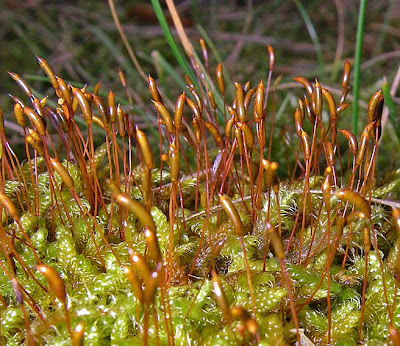If you are a botanist, mid-winter can be a bit of a lean time of the year unless you turn your attention to some of the smaller members of the plant kingdom - like mosses, for example. They're evergreen and many species make a lot of growth during milder periods in winter. Indeed, for species that live in woodland or amongst grass winter is their window of opportunity, when there's plenty of light available, before they are shaded by a woodland canopy or lush grassland sward. Add to that the fact that many mosses switch into reproductive mode in autumn and winter and produce their spore capsules, and that there are an awful lot of species out there, and you soon find that these diminutive plants have their own particular fascination. The example above, producing a forest of spore capsules, is Dicranoweisia cirrata or, more prosaically, common pincushion moss - a species with a liking for colonising the tops of old fence posts.
This is one of the commonest of all mosses, Hypnum cupressiforme or cypress-leaved plait moss. This picture is a bit small but if you double-click on it (and all the others, for that matter) the resemblance to the scaly leaves of a cypress tree is evident and the leaves do look as though they've been plaited, although .....
... if you look at the shoots sideways-on another distinguishing feature is revealed - the way in which all the leaves curve in the same direction on the underside of the shoots.
There are several varieties of Hypnum cupressiforme that are given their own specific names by dedicated bryologists (botanists who study mosses). This is probably the most typical version though, which produces a forest of tan-coloured spore capsules at this time of year. Sometimes you'll find whole fallen tree trunks covered with a silky mat of this moss.
This species, which grows in short grass, often on bank tops, is Pseudoscleropodium purum (say it slowly and savour the name, it has a nice alliterative sound to it, even if you have an aversion to Latin names). Its common name is neat feather moss and it's distinctive feature is the way its neat, cusp-shaped leaves overlap one another, giving the shoots this stout, swollen look.
And finally, another moss growing here on top of a grassy bank - the splendid Hylocomium splendens, also known as glittering wood-moss, with its magnificent red stems.
So that's four species - now I need to learn to identify the remaining 759 species....
For more on mosses, click here...
... and for a review of an interesting-sounding book on mosses (which I haven't read yet), take a look at Lesley's Blooms and Beasties Blog...





























I didn't even know that theree were so many different kinds. Thanks for the info.
ReplyDeleteAh - brings back memories of the moss class I took in grad school. Love the names. My favorite is Ceratodon purpurea - sounds like some kind of dinosaur.
ReplyDeleteI am such a sucker for mosses; love to see them anytime. Your photos are a delight to behold.
ReplyDeleteA fascinating subject Phil. Such tiny plants, yet each with its own beauty; and so many of them too!
ReplyDeleteThank you for the reference to my blog post Phil. What a lovely start to my day! :D
ReplyDeleteNearly 800 species! That's amazing. There's a wall round someone's garden in Bishop Auckland I used to pass regularly, that has various species of moss growing on it. I'm not sure what kind of stone the wall is made of, but it looks beautiful with its mossy covering. I had to pause to look at it every time I passed by...... and usually a gentle touch too as they're so tactile. :)
The older I get the more I realise it is the smaller aspects of our natural world that power the planet, and are just as beautiful as our mega fauna and flora. Great posting.
ReplyDeleteThey all have their own beauty when seen close up.
ReplyDeleteWhen I was trying to identify the moss in my lawn I couldn't find a picture to match when I went searching - far too many to choose from ;)
Hi lotusleaf, many species are very widely distributed too, because their spores are carried long distances on air currents
ReplyDeleteHi Elle, I link the sound of Rhytidiadelpus too.....
ReplyDeleteThanks Wilma, I like the fact that they're so persistant too - surviving for half a billion years and five mass extinctions is prett impressive for such seemingly fragile plants..
ReplyDeleteHi Keith, they fall into that category of 'the closer you look, the more interesting they become...'
ReplyDeleteHi Lesley, I'm particularly fond of the little hemispherical cushions of Grimmia moss that you find on wall tops..
ReplyDeleteCouldn't agree with you more Wessex Reiver...
ReplyDeleteHi John, there's a moss called Rhytidiadelphus squarrosus aka springy turf moss that turns up frequently in lawns...
ReplyDeleteThanks for that Phil. It looks very much like the one I have here.
ReplyDelete